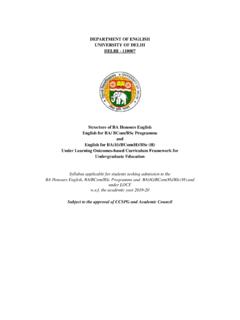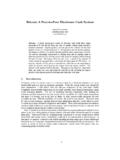Transcription of The Arabian Nights: Tales of 1,001 Nights: Volume 1
1 PENGUIN CLASSICSTHE Arabian NIGHTSTALES OF 1001 NIGHTSVOLUME 1 MALCOLM C. LYONS, sometime Sir Thomas Adams Professor of Arabic atCambridge University and a life Fellow of Pembroke College, cambridge ,is a specialist in the field of classical Arabic literature . His publishedworks include the biography Saladin: The Politics of the Holy War, TheArabian Epic: Heroic and Oral Storytelling, Identification and Identity inClassical Arabic Poetry and many articles on Arabic LYONS, formerly an Affiliated Lecturer at the Faculty of OrientalStudies at cambridge University and, since 1976, an Emeritus Fellow ofLucy Cavendish College, cambridge , specializes in modern IRWIN is the author of For Lust of Knowing: The Orientalists andTheir Enemies, The Middle East in the Middle Ages, The Arabian Nights: ACompanion and numerous other specialized studies of Middle Easternpolitics, art and mysticism.
2 His novels include The Limits of Vision, TheArabian Nightmare, The Mysteries of Algiers and Satan Wants 1 Nights 1 to 294 Translated by MALCOLM C. LYONS,with URSULA LYONSI ntroduced and Annotated by ROBERT IRWINPENGUIN BOOKSPENGUIN CLASSICSP ublished by the Penguin GroupPenguin Books Ltd, 80 Strand, London WC2R 0RL, EnglandPenguin Group (USA) Inc., 375 Hudson Street, New York, New York 10014, USAP enguin Group (Canada), 90 Eglinton Avenue East, Suite 700, Toronto, Ontario, Canada M4P 2Y3(a division of Pearson Penguin Canada Inc.)Penguin Ireland, 25 St Stephen s Green, Dublin 2, Ireland (a division of Penguin Books Ltd)Penguin Group (Australia), 250 Camberwell Road, Camberwell, Victoria 3124, Australia(a division of Pearson Australia Group Pty Ltd)Penguin Books India Pvt Ltd, 11 Community Centre, Panchsheel Park, New Delhi 110 017,IndiaPenguin Group (NZ), 67 Apollo Drive, Rosedale, North Shore 0632, New Zealand(a division of Pearson New Zealand Ltd)Penguin Books (South Africa) (Pty) Ltd, 24 Sturdee Avenue, Rosebank,Johannesburg 2196, South AfricaPenguin Books Ltd, Registered Offices: 80 Strand, London WC2R 0RL, of Nights 1 to 294, Note on the Translation and Note on the Textcopyright Malcolm C.
3 Lyons, 2008 Translation of The story of Ali Baba and the forty thieves killed by a slave girl and TranslatingGalland copyright Ursula Lyons, 2008 Introduction, Glossary, Further Reading and Chronology copyright Robert Irwin, 2008 All rights reservedThe moral right of the translators and editor has been assertedText illustrations design by Coralie Bickford-Smith; images: Gianni Dagli Orti/Museo Correr,Venice/The Art ArchiveExcept in the United States of America, this book is sold subject to the condition that it shall not,by way of trade or otherwise, be lent, re-sold, hired out, or otherwise circulated without thepublisher s prior consent in any form of binding or cover other than that in which it is publishedand without a similar condition including this condition being imposed on the subsequentpurchaserISBN: 978-0-14-194350-3 Editorial NoteIntroductionA Note on the TranslationA Note on the TextTranslating GallandThe Arabian Nights.
4 Nights 1 to 294 The story of Ali Baba and the forty thieves killed by a slave girlGlossaryChronologyFurther ReadingMapsThe Abbasid Caliphate in the Ninth CenturyBaghdad in the Ninth CenturyCairo in the Fourteenth CenturyIndex of Nights and StoriesThis new English version of The Arabian Nights (also known as TheThousand and One Nights) is the first complete translation of the Arabictext known as the Macnaghten edition or Calcutta II since RichardBurton s famous translation of it in 1885 8. A great achievement in itstime, Burton s translation nonetheless contained many errors, and evenin the 1880s his English read this new edition, in addition to Malcolm Lyons s translation of allthe stories found in the Arabic text of Calcutta II, Ursula Lyons hastranslated the Tales of Aladdin and Ali Baba, as well as an alternativeending to The seventh journey of Sindbad , from Antoine Galland seighteenth-century French.
5 (For the Aladdin and Ali Baba stories nooriginal Arabic text has survived and consequently these are classed as orphan stories .)The text appears in three volumes, each with an introduction, which,in Volume 1, discusses the strange nature of the Nights; in Volume 2,their history and provenance; and, in Volume 3, the influence the taleshave exerted on writers through the centuries. Volume 1 also includes anexplanatory note on the translation, a note on the text and anintroduction to the orphan stories ( Editing Galland ), in addition to achronology and suggestions for further reading. Footnotes, a glossaryand maps appear in all three often happens in popular narrative, inconsistencies andcontradictions abound in the text of the Nights. It would be easy toemend these, and where names have been misplaced this has been doneto avoid confusion.
6 Elsewhere, however, emendations for which there isno textual authority would run counter to the fluid and uncritical spiritof the Arabic narrative. In such circumstances no changes have story collection of The Arabian Nights has drawn on many culturesand sources Indian, Persian, Greek. One of its parallel sources, whichdrew on the same ancient Indian materials, is a Sanskrit text known asthe Kathasaritsagara, or The Ocean of the Streams of Story , compiled bythe eleventh-century author Somadeva. The Arabian Nights is, like theKathasaritsagara, a vast storytelling ocean in which the readers can losethemselves. One story, like a wave, is absorbed into the one that drift of the narrative tides carries us, like Sindbad, to strange places,and the further from home, the stranger those places are. Within thestories themselves, the sea operates as the agent of destiny which carriesships, men and magically sealed bottles and casts them upon unexpectedshores: the Island of Waq-Waq where the women grow from trees, theisland of the Magnetic Mountain presided over by its talismanic statue,the Black Islands of the Ensorcelled Prince and the islands of China.
7 Thetides are unpredictable, and men s fortunes founder and are wreckedupon the sea of vastness and complexity of the Nights is mesmerizing. In her story The Djinn in the Nightingale s Eye (1994), A. S. Byatt has written:What delights above all in the Arabian Nights is its form. Story is embedded in story, storysprouts out of the midst of story, like the Surinam toads out of the back of their mothertoad, which Coleridge used as a metaphor for his unruly imagination. The collectionresembles both a group of Russian dolls, formally similar, faces and colours different, anda maze or spider-web with threads and passages leading in all directions, both formlessand orderly at motifs within the Nights combine and recombine: the ageing andchildless couple who, having prayed for a son, find that their wish isgranted; the merchant who sits minding his business when a veiledwoman enters his shop and summons him to follow her; the man who istold that he may explore every room in the palace save only one room,which is locked; the squandering of his deceased father s fortune by afeckless youth; the fisherman who casts his net upon the waters but atfirst has no luck; the young man who is smuggled into the caliph sharem.
8 The curiously assembled queue of people each of whom swearsthat he or she can tell a tale yet more remarkable than the one they havejust heard. The stories are full of echoes and half echoes of one another,like recurrent dreams in which the landscape is thoroughly familiar,though what is to come is utterly unpredictable. The stories devices arerecombined, inverted or truncated in what comes to seem like acomplete spectrum of storytelling Surinam one story frames another, which in turncontains yet another within it, and so on and so on. The French refer tothis sort of framing procedure as the mise en ab me, the thrust into theabyss. Shahrazad, talking in an attempt to save her life, tells the tale ofthe hunchback, and that includes the tale of the tailor, and the tailortells the tale of the barber, and the barber tells his own tale, and withinthat are the Tales of his various unlucky brothers.
9 Such a Chinese-boxstructure as an organizing device in fiction has its counterpart in reallife, wherein we are all of us the stories we carry within us, but thatmaster story contains also the stories of our family and friends, andperhaps the newsagent and the postman, and perhaps what the postmantold you about his brother and the story the brother was told by a touristhe met in Italy, and so on. To look at it from the opposite direction, eachof us embodies a life story and our stories get inserted into theoverarching master stories of other people we know just as, withouthaving any choice in the matter, we may appear in the dreams of peoplewe tells stories in order to postpone her death. But death, thedestroyer of delights , is implicitly or explicitly the terminator of all thestories she tells and, in this sense, whether a prince marries a princess ora poor fisherman wins his just reward from the caliph, all stories willend unhappily if carried through to their inevitable conclusion.
10 TheAngel of Death, a protagonist in several stories, is unfailinglyintransigent. The calender dervishes, whom Shahrazad has relating thestories of their adventures, are nothing other than the stories that theytell about themselves. The same is true of Sindbad, and of the sequenceof people that manhandled the corpse of the hunchback from place toplace and then, in order to save themselves from being executed for thehunchback s murder, tell the stories of their strange adventures. As inmedieval fiction, so, in real life, we are the stories we tell aboutourselves. And our Tales are told in order to postpone the coming of thedestroyer of all delights .The stories that Shahrazad relates in order to delay her execution aretold at night, and they cease abruptly when dawn breaks. Stories arebest told at night. Since listening to stories in Arab society was regardedas less sinful after the day s work was done, stories were known asasmar, things of the evening or Tales related in the night foramusement.





